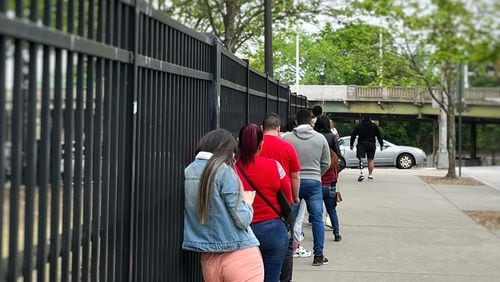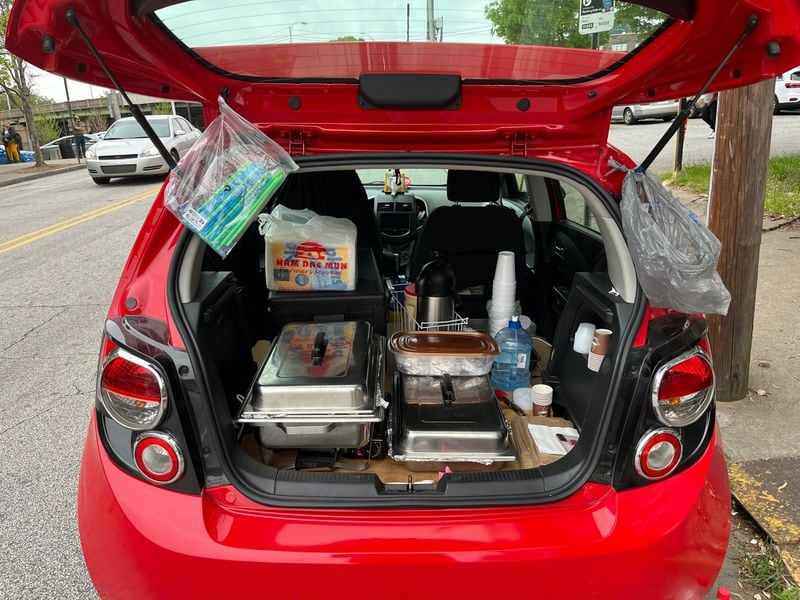At around 7 a.m. on a recent Tuesday morning, a line of immigrants stretched across two downtown Atlanta sidewalks, as the early risers waited to check in with immigration authorities.
The queue began at the entrance of U.S. Immigration and Customs Enforcement’s Atlanta field office on Ted Turner Drive and snaked around the corner, in the direction of the nearby Greyhound bus station. At the front of the line, a woman said she’d arrived at 4 a.m. from LaGrange to claim her spot.
Among the roughly 100 people behind her were a childcare worker from Norcross, a landscaper from Carrollton and a floor-layer from Macon. Many came with small children. The nationalities represented included Venezuela, Mexico, Nicaragua, Honduras, and many more. They were gathered to see immigration agents because, for many people living in the U.S. without authorization, regular check-ins at the nearest ICE office are a mandatory part of their case. Migrants who cross the border illegally and are released by authorities into the country typically must attend their first check-in within 60 days.
This early morning line in front of the Atlanta ICE office, which forms most weekdays, is evidence of a population that typically remains invisible. That’s especially true in Georgia, where there are no shelters for recent arrivals. And a recently passed law would require local police to help arrest and detain undocumented immigrants, a move advocates warn could drive people without status further in the shadows.
Still, more and more people are making their way to the state from the southern border. In fiscal years 2022 and 2023, Georgia tallied the seventh-highest number of new immigration cases in the country, according to data from Syracuse University’s Transactional Records Access Clearinghouse (TRAC). Longtime immigration watchers say that the lines at the Atlanta ICE office have recently grown to unprecedented lengths.
“I haven’t seen this in 25 years,” said Charles Kuck, a longtime Atlanta-area immigration attorney.
The foot traffic has created a business opportunity. On the recent Tuesday, a woman walked alongside the line offering arepas, cups of coffee, and other breakfast items, sold out of the trunk of her car. She called prospective clients “mi amor,” or “my love.”
Credit: Lautaro Grinspan
Credit: Lautaro Grinspan
People in line said they lamented having to take a day off work to check in with ICE — immigrants familiar with the process said it can take up to five hours before they’re able to leave — but that they largely weren’t nervous or scared about meeting with the authorities in this setting.
“What’s actually scary is if you don’t show up. Then, it’s like you’re a fugitive,” said a woman from Cuba, who wished to keep her name private so as to not impact her immigration case. “We came to this country under that condition. … The reality is, we committed a crime” by crossing the border without authorization.
“If you miss a check-in date, you lose everything, everything you sacrificed to get here,” added a man from Nicaragua.
The Atlanta field office is ICE’s only Georgia outpost.
“If clients want us to represent them, they need to show up” to check-ins, Kuck said. “Some people are afraid of being detained. But ICE is not going to detain you there. They don’t have the capacity.”
The purpose of the check-ins, which migrants must show up for roughly every six months, is to ensure people are where they are supposed to be, and that they remain on-track with their respective immigration cases.
Migrants “may have a brief encounter at the border, but ours is the first real encounter they’re having out here. Hence the long lines, because it’s a lot of work, making sure that folks are put into the system and put into the process,” said Sean Ervin, ICE’s Atlanta field office director.
Added Kuck: “Why do you go report to a probation officer? Just to make sure. Just to make sure we’ve got our eye on you. I mean, there’s that effect as well: ‘I’ve got to be good because ICE is watching me.’ We get to know where they are. And if they don’t show up ICE can begin looking for them.”
An average of 3,300 people stood in line to check-in at the Atlanta ICE field office in both February and March, according to agency data. That’s up from a monthly average of 2,400 during November through January, a change that an ICE spokesperson said was likely related to the holiday season. The agency did not provide check-in data going further back in time, but Ervin confirmed that the number of people in line is up from years prior, due to the recent surges at the border.
An ‘overwhelmed’ system
Spending hours every few months waiting in line at an ICE office in the U.S. is a fate preferable to detention or deportation. In some ways, it represents the best-case scenario for migrants crossing the border illegally.
Last year, the Biden administration rolled out new restrictions on asylum. Anyone who reaches U.S. soil has the right to apply for asylum, regardless of how they got here. If they’re successful, the designation allows them to stay legally.
Under the tougher rules, officials who screen migrants at the border are rejecting more than twice as many asylum claims as they did a year ago and referring the migrants behind those claims for deportation, according to a Washington Post analysis of federal data. But there aren’t enough officers to screen everyone coming through for asylum eligibility. And detention capacity is too limited for the government to hold others long enough to interview them.
For migrants apprehended at the border, that means there is significant unpredictability in the treatment they will receive. And experts say that, as long as large numbers of border crossers continue to be released into the country for lack of government resources, others will be motivated to follow in their footsteps and make the same journey north.
“You just never have any idea what’s going to happen. Some folks are turned back, other folks are being taken into ICE custody, other folks are released. It’s like roulette,” said Marty Rosenbluth, an immigration attorney who represents migrants locked up at the Stewart Detention Center in southwest Georgia. He said a recent case of his involved twin sisters who crossed the border together. One was detained at Stewart while the other was released into the country.
Harsher but not universally applied asylum restrictions “are not in any way, shape or form a deterrent because people know that they might get through,” he added. “They are willing to roll the dice and hope they get lucky.”
In February, Georgia U.S. Sens. Jon Ossoff and Raphael Warnock joined the majority of their Democratic colleagues in supporting a bipartisan Senate bill that would have expanded deportation capacity at the border and provided funds to hire thousands of new asylum officers. But the bill succumbed to Republican opposition.
Unprecedented flows of migrants haven’t just been straining officials at the border. They’re also contributing to growing backlogs in immigration courts across the U.S., where asylum cases are ultimately decided. The result is that even migrants with flimsy asylum claims can legally live and work in the country for years before their day in court comes, provided they keep up with requirements like regular check-ins at ICE field offices.
To qualify for asylum, migrants must prove that they face persecution in their home countries on the basis of race, religion, gender, political opinion or membership in a particular social group – a standard most applicants in recent years haven’t met, according to data compiled by TRAC. Searching economic opportunity or fleeing gang violence, both notable drivers fueling migration from places like Central America, isn’t grounds for asylum protections.
“The system is completely overwhelmed because of how many asylum cases there are,” Kuck said.
In fiscal year 2023 alone, immigration courts countrywide received 1.2 million new asylum cases, most from recent border arrivals. The courts’ backlog is now triple what it was in 2019, and immigration judges’ average caseload has grown to 5,000 per judge.
Letting people who may not qualify for asylum live in the country for years “is not fair to America,” Kuck said. “You want to be able to process somebody quickly and deport them if they don’t meet the standard.”
For migrants who do have valid asylum claims, long waits to see a judge may also put them at a disadvantage.
“Evidence gets stale, memories fade, people get confused, witnesses become unavailable. Now, you’ve made the case much harder to win,” Kuck said. “The broken system has real life consequences.”
Underpinning the dysfunction is a simple math problem: the number of migrants at the border far outstrips the number of government workers tasked with managing the influx.
Federal agencies that deal with migration are “doing the best they can,” Kuck said. “They’re just understaffed and under resourced.”
Irvin estimated that the total number of employees at the Atlanta ICE field office is under 400. He said it is a smaller workforce than those found in most local field offices.
Staff writer Michelle Baruchman contributed to this report.
The Atlanta Journal-Constitution and Report for America are partnering to add more journalists to cover topics important to our community. Please help us fund this important work here.
About the Author








